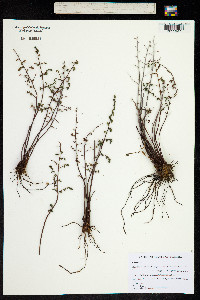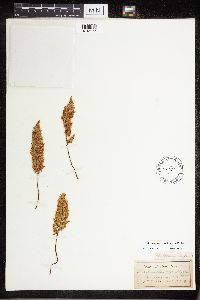Myriopteris yavapensis
|
|
|
|
Family: Pteridaceae
Graceful Lip Fern, more...graceful lipfern, lipfern (es: helecho)
[Cheilanthes yavapensis Reeves ex Windham] |
Stems long-creeping, 1--3 mm diam.; scales often bicolored, with broad, poorly defined, dark, central stripe and narrow, brown margins, lanceolate, straight to slightly contorted, strongly appressed, persistent. Leaves scattered, 7--35 cm; vernation noncircinate. Petiole dark brown, rounded adaxially. Blade oblong-lanceolate to nearly ovate, 4-pinnate at base, 2--6 cm wide; rachis rounded adaxially, with scattered linear-lanceolate scales and sparse monomorphic pubescence. Pinnae not articulate, dark color of stalk continuing into pinna base, basal pair not conspicuously larger than adjacent pair, usually equilateral, appearing sparsely pubescent adaxially. Costae green adaxially for most of length; abaxial scales multiseriate, lanceolate, truncate to cordate at base, without overlapping basal lobes, conspicuous, the largest 0.4--1 mm wide, strongly imbricate, often concealing ultimate segments, ciliate, cilia coarse, usually distributed entire length of scale. Ultimate segments round to oblong, beadlike, the largest usually 1--2 mm, abaxially glabrous or with a few small scales near base, adaxially appearing sparsely pubescent but actually nearly glabrous. False indusia marginal, weakly differentiated, 0.05--0.25 mm wide. Sori ± continuous around segment margins. Sporangia containing 32 spores. n = 2 n = 120, apogamous. Sporulating summer--fall. Rocky slopes and ledges, usually on igneous substrates; 500--2400 m; Ariz., N.Mex., Tex. Cheilanthes yavapensis is an apogamous tetraploid, apparently formed by hybridization between C . lindheimeri and C . covillei (G. J. Gastony and M. D. Windham 1989). Although C . yavapensis has long been included within the concept of C . wootonii , the discovery that the similarities resulted from hybrid convergence rather than common ancestry requires that they be recognized as two distinct species. Unfortunately, the morphologic characteristics that separate these taxa are subtle, and careful study will be necessary to determine the proper dispositon of problematic specimens. In addition to the characteristics mentioned in the key, C . yavapensis is distinguished from C . wootonii by having larger spores, averaging more than 62 µm in diameter.
General: Scattered leaves 7-35 m tall, from long-creeping stems, 1-3 mm in diameter, with bicolored scales, with poorly defined central strip and narrow brown margins, strongly appressed and persistent, noncircinate vernation. Leaves: On dark brown petiole, rounded above, blade oblong-lanceolate to nearly ovate, 4-pinnate at base, 2-6 cm wide, rachis rounded above, with scattered linear-lanceolate scales and monomorphic pubescence; pinnate not articulate, appearing sparsely pubescent above; costae green, scales below multiseriate, lanceolate, truncate to cordate at base, without overlapping basal lobes, largest 0.4-1 mm wide, strongly imbricate, with coarse cilia, usually distributed entire length of scale; ultimate segments round to oblong and beadlike, largest 1-2 mm, glabrous below or with few scales at base, sparsely pubescent above, but nearly glabrous. Sporangia: False indusia margin, sori continous around segment margins, apogamous. Ecology: Found on rocky slopes and ledges, usually on igneous substrates from 2,000-8,000 ft (610-2438 m); sporulates summer-fall. Notes: FNA understands this species to be a hybrid between C. lindheimeri and C. covillei. The morphological characteristics of this taxa are subtle. Collection of this species is necessary for proper identification. Etymology: Cheilanthes is from Greek cheilos for lip and anthos for flower, while yavapensis is a derivative of the word Yavapai, a Yuman word for the people, a known group of Apache who inhabited the Verde Valley and surrounding lands in central Arizona. Sources: FNA 1993 FNA 1993 Common Name: graceful lipfern Rarity: None General: Scattered leaves 7-35 m tall, from long-creeping stems, 1-3 mm in diameter, with bicolored scales, with poorly defined central strip and narrow brown margins, strongly appressed and persistent, noncircinate vernation. Leaves: On dark brown petiole, rounded above, blade oblong-lanceolate to nearly ovate, 4-pinnate at base, 2-6 cm wide, rachis rounded above, with scattered linear-lanceolate scales and monomorphic pubescence; pinnate not articulate, appearing sparsely pubescent above; costae green, scales below multiseriate, lanceolate, truncate to cordate at base, without overlapping basal lobes, largest 0.4-1 mm wide, strongly imbricate, with coarse cilia, usually distributed entire length of scale; ultimate segments round to oblong and beadlike, largest 1-2 mm, glabrous below or with few scales at base, sparsely pubescent above, but nearly glabrous. Sporangia: False indusia margin, sori continous around segment margins, apogamous. Ecology: Found on rocky slopes and ledges, usually on igneous substrates from 2,000-8,000 ft (610-2438 m); sporulates summer-fall. Notes: FNA understands this species to be a hybrid between C. lindheimeri and C. covillei. The morphological characteristics of this taxa are subtle. Collection of this species is necessary for proper identification. Ethnobotany: Unknown Etymology: Cheilanthes is from Greek cheilos for lip and anthos for flower, while yavapensis is a derivative of the word Yavapai, a Yuman word for the people, a known group of Apache who inhabited the Verde Valley and surrounding lands in central Arizona. Synonyms: None Editor: SBuckley, 2010 |
|
|
|
































































































